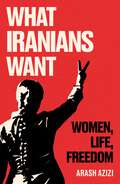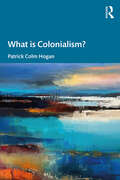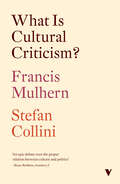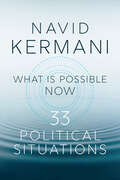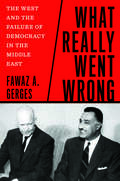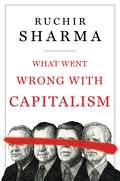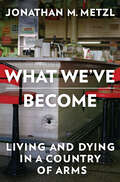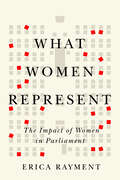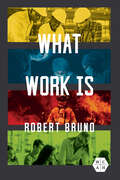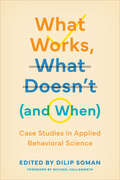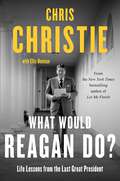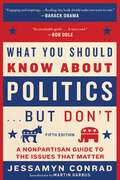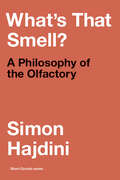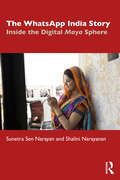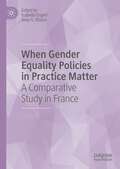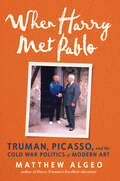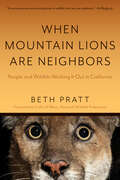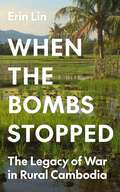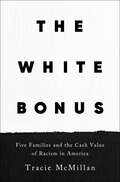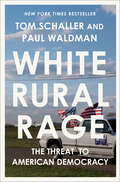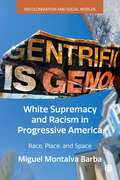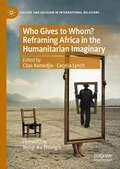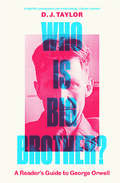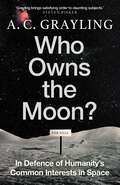- Table View
- List View
What Iranians Want: Women, Life, Freedom
by Arash Azizi'A document of real optimism.' Guardian On Tuesday 13 September 2022, all Mahsa Amini has planned is a day shopping in Tehran. Her birthday is next week. But she is arrested as she comes out of the subway – the Guidance Patrol deem her hijab inadequate. On Friday she is pronounced dead. By Sunday, women have taken to the streets across Iran, setting their headscarves on fire and cursing the Supreme Leader. Months later, workers down their tools and businesses close. The battle cry everywhere: Women, Life, Freedom. This isn&’t a passing protest wave; something has changed irrevocably. Arash Azizi guides us through Iran ablaze, history being made in real time. From an International Women&’s Day celebrated inside Iran&’s most notorious prison to mass strikes in Kurdistan, ordinary Iranians are taking risks to fight for a better future. Even as the regime spills blood in retaliation, Iranians have not given up. Today one thing&’s clear: no Supreme Leader can turn the clock back. A different Iran is within sight; Azizi shows us what it might look like.
What is Colonialism?
by Patrick Colm HoganWhat is Colonialism? develops a clear and rigorous account of what colonialism is and how it works. It draws on and synthesizes recent work in cognitive science, affective science, and social psychology, along with Marxism and related forms of analysis. Hogan begins with some fundamental conceptual distinctions, such as the degree to which a group shares beliefs, dispositions, and skills versus the degree to which they share identification with a category. Building on these distinctions, he defines colonialism in terms of political, economic, and cultural autonomy, clarifying the nature of culture and autonomy particularly. He goes on to articulate an invaluable systematic account of the varieties of colonialism. The final chapters outline the motives of imperialists, differentiating these from their ideological rationalizations, and sketching the harms caused by colonialism. The book concludes by considering when, or if, one can achieve a genuinely postcolonial condition. Hogan illustrates these analyses by examining influential literary works—by European writers (such as Joseph Conrad) and by non-Europeans (such as Athol Fugard, Kamala Markandaya, and Wole Soyinka). This accessible and informative volume is the ideal resource for students and scholars interested in colonialism and empire.
What Is Cultural Criticism?
by Stefan Collini Francis MulhernTwo leading critics grapple with problems of literature, politics and intellectual practiceIn What Is Cultural Criticism?, two leading critics grapple with problems of literature, politics and intellectual practice. The debate opens with Francis Mulhern&’s account of what he terms &‘metacultural discourse&’. This embraces two opposing critical traditions, the elite pessimism of Kulturkritik and the populist enthusiasms of Cultural Studies. Each in its own way dissolves politics into culture, Mulhern argues. Collini, on the other hand, protests that cultural criticism provides resources for genuine critical engagement with contemporary society. Tension between culture and politics there may be, but it works productively in both directions.This widely noticed encounter is that rare thing, a sustained debate in which, as Collini remarks, the protagonists not only exchange shots but also ideas. It concludes with Mulhern&’s engagement with Collini&’s writing on the subordination of universities to metrics and bureaucracy, and a companion rejoinder from Collini on Mulhern&’s study of the &‘condition of culture novel&’ and his essays on questions of nationality and the politics of intellectuals.
What is Possible Now: 33 Political Situations
by Navid KermaniNavid Kermani is one of the outstanding public intellectuals of his generation. Not one for drawing hard and fast conclusions, his style of thought is probing, observant, often straying from well-trodden paths and always peering beyond the present moment to trace connections and grasp the bigger picture. Well known for his prize-winning novels and major works of non-fiction, Kermani has also gained widespread acclaim as a journalist, displaying a rare political sensitivity which manages to illuminate what politicians fail to see and to seek out solutions where all appears hopeless. This volume brings together his brilliantly perceptive writing from the last thirty years, on topics ranging from terror in the Middle East to Russia’s invasion of Ukraine. As a record of Kermani’s uniquely compassionate curiosity, this absorbing book is a welcome antidote to the confusion and despair that stalks global politics today.
What Really Went Wrong: The West and the Failure of Democracy in the Middle East
by Fawaz A. GergesAn ambitious revisionist history of the modern Middle East What Really Went Wrong offers a fresh and incisive assessment of American foreign policy&’s impact on the history and politics of the modern Middle East. Looking at flashpoints in Iranian, Egyptian, Syrian, and Lebanese history, Fawaz A. Gerges shows how postwar U.S. leaders made a devil&’s pact with potentates, autocrats, and strongmen around the world. Washington sought to tame assertive nationalists and to protect repressive Middle Eastern regimes in return for compliance with American hegemonic designs and uninterrupted flows of cheap oil. The book takes a counterfactual approach, asking readers to consider how the political trajectories of these countries and, by extension, the entire region may have differed had U.S. foreign policy privileged the nationalist aspirations of patriotic and independent Middle Eastern leaders and people. Gerges argues that rather than focusing on rolling back communism, extracting oil, and pursuing interventionist and imperial policies in Iran, Egypt, and beyond, postwar U.S. leaders should have allowed the Middle East greater autonomy in charting its own political and economic development. In so doing, the contemporary Middle East may have had better prospects for stability, prosperity, peace, and democracy.
What This Comedian Said Will Shock You
by Bill MaherThe hilarious and controversial host of HBO’s Real Time with Bill Maher has written his funniest, most opinionated, and most necessary book ever—a brilliantly astute and acerbically funny vivisection of American life, politics, and culture. <P><P> Some of the smartest commentary about what’s happening in America is coming from a comedian—this comedian being Bill Maher. If you want to understand what’s wrong with this country, it turns out that one of the best informed and most thought-provoking analysts is this very funny pothead. <P><P> The book was inspired by the “editorial” Bill delivers at the end of each episode of Real Time. These editorials are direct-to-camera sermons about culture, politics, and what’s happening in the world. To put this book together, Maher reviewed more than a decade of his editorials, rewriting, reimagining, and updating them, and adding new material to speak exactly to the moment we’re in. Free speech, cops, drugs, race, religion, the generations, cancel culture, the parties, the media, show biz, romance, health—Maher covers it all. The result is a hugely entertaining work of commentary about American culture in the tradition of Mark Twain, Will Rogers, and H. L. Mencken. <p> <b>New York Times Bestseller</b>
What Went Wrong with Capitalism
by Ruchir SharmaA century of expanding government has distorted financial markets, stoked massive inequality, and soaked America in debt.Capitalism didn&’t fail, it was ruined... What went wrong with capitalism? Ruchir Sharma&’s account is not like any you will have heard before. He says progressives are right, in part, when they mock modern capitalism as &“socialism for the rich.&” For a century, governments have expanded in just about every measurable dimension, from spending to regulation and the scale of financial rescues when the economy wobbles. The result is expensive state guarantees for everyone—bailouts for the rich, entitlements for the middle class, welfare for the poor. Taking you back to the 19th century, Sharma shows how completely the reflexes of government have changed: from hands-off to hands-on, from doing too little to help anyone in hard times to today trying to prevent anyone suffering any economic pain, ever. Trading sins of omission and indifference for excesses of spending and meddling, governments from the United States to Europe and Japan have pumped so much money into their economies that financial markets can no longer invest all that capital efficiently. Inadvertently, they have fueled the rise of monopolies, &“zombie&” firms, and billionaires. They have made capitalism less fair and less efficient, which is slowing economic growth and fueling popular anger. The first step to a cure is a correct diagnose of the problem. Capitalism has been badly distorted by constant government intervention and the relentless spread of a bailout culture. Building an even bigger state will only double down on what ruined capitalism in the first place.
What We've Become: Living and Dying in a Country of Arms
by Jonathan M. MetzlA searing reflection on the broken promise of safety in America. When a naked, mentally ill white man with an AR-15 killed four young adults of color at a Waffle House, Nashville-based physician and gun policy scholar Dr. Jonathan M. Metzl once again advocated for commonsense gun reform. But as he peeled back evidence surrounding the racially charged mass shooting, a shocking question emerged: Did the public health approach he had championed for years have it all wrong? Long at the forefront of a movement advocating for gun reform as a matter of public health, Metzl has been on constant media call in the aftermath of fatal shootings. But the 2018 Nashville killings led him on a path toward recognizing the limitations of biomedical frameworks for fully diagnosing or treating the impassioned complexities of American gun politics. As he came to understand it, public health is a harder sell in a nation that fundamentally disagrees about what it means to be safe, healthy, or free. In What We’ve Become, Metzl reckons both with the long history of distrust of public health and the larger forces—social, ideological, historical, racial, and political—that allow mass shootings to occur on a near daily basis in America. Looking closely at the cycle in which mass shootings lead to shock, horror, calls for action, and, ultimately, political gridlock, he explores what happens to the soul of a nation—and the meanings of safety and community—when we normalize violence as an acceptable trade-off for freedom. Mass shootings and our inability to stop them have become more than horrific crimes: they are an American national autobiography. This brilliant, piercing analysis points to mass shootings as a symptom of our most unresolved national conflicts. What We’ve Become ultimately sets us on the path of alliance forging, racial reckoning, and political power brokering we must take to put things right.
What Women Represent: The Impact of Women in Parliament
by Erica RaymentPolitical equity advocates and academics often argue that we must elect more women, but what difference does it make if we do? What Women Represent shows that women can and do influence the issues raised and the decisions made in parliamentary debate and decision-making.Using a new framework for thinking about what it means for legislators to represent women and drawing on a database that encompasses five decades of debate in the House of Commons, Erica Rayment investigates which members of Parliament represent women and what issues they address. She then examines the role women parliamentarians played in two instances where governments threatened to curtail previous gender equality gains: the Mulroney government’s attempted recriminalization of abortion and the Harper government’s plans to cut funding and weaken the mandate of Status of Women Canada. Rayment’s analysis decisively shows that parliamentary presence matters for the representation of women’s interests; women MPs, regardless of party, are more likely to act for women and play a critical role when the rights of women are at stake.What Women Represent is the first large-scale analysis of the substantive representation of women in Canadian politics, adding depth and nuance to our understanding of issues of gender in parliamentary institutions.
What Work Is (Working Class in American History)
by Robert BrunoA distinctive exploration of how workers see work For more than twenty years, Robert Bruno has taught labor history and labor studies to union members from a wide range of occupations and demographic groups. In the class, he asked his students to finish the question “Work is—?” in six words or less. The thousands of responses he collected provide some of the rich source material behind What Work Is. Bruno draws on the thoughts and feelings experienced by workers in the present day to analyze how we might design a future of work. He breaks down perceptions of work into five categories: work and time; the space workers occupy; the impact of work on our lives; the sense of purpose that motivates workers; and the people we work for, in all senses of the term. Far-seeing and sympathetic, What Work Is merges personal experiences with research, poetry, and other diverse sources to illuminate workers’ lives in the present and envision what work could be in the future.
What Works, What Doesn’t: Case Studies in Applied Behavioral Science (Behaviorally Informed Organizations)
by Dilip SomanHow well do behavioral science interventions translate and scale in the real world? Consider a practitioner who is looking to create behavior change through an intervention – perhaps it involves getting people to conserve energy, increase compliance with a medication regime, reduce misinformation, or improve tax collection. The behavioral science practitioner will typically draw inspiration from a previous study or intervention to translate into their own intervention. The latest book in the Behaviourally Informed Organizations series, What Works, What Doesn’t (and When) presents a collection of studies in applied behavioral research with a behind-the-scenes look at how the project actually unfolded. Using seventeen case studies of such translation and scaling projects in diverse domains such as financial decisions, health, energy conservation, development, reducing absenteeism, diversity and inclusion, and reducing fare evasion, the book outlines the processes, the potential pitfalls, as well as some prescriptions on how to enhance the success of behavioral interventions. The cases show how behavioral science research is done – from getting inspiration to adapting research into context, designing tailored interventions, and comparing and reconciling results. With contributions from leading academics and seasoned practitioners, What Works, What Doesn’t (and When) provides prescriptive advice on how to make behavior change projects happen and what pitfalls to watch out for.
What Would Reagan Do?: Life Lessons from the Last Great President
by Chris ChristieWith the nation badly divided and the two major parties on a bitter collision course, what can we learn from America&’s last great president?A lot, says New York Times bestselling author and former New Jersey governor Chris Christie. In What Would Reagan Do?, Christie takes a fresh look at President Ronald Reagan&’s character-driven political instincts and deeply impactful relationships across party lines—finding plenty of compelling insights for our current national dysfunction. In each chapter, Christie spells out a lesson from a different point in Reagan&’s journey, then ties all those lessons to the national challenges of today. When Reagan turned from Hollywood to politics, America was at another breaking point. The economy was battered. Trust in government was at an all-time low. US foreign policy was an embarrassment, and Western ideals were facing enormous challenges in the world, especially from the Russians and the Chinese. Sound familiar? Enter a fading actor who would become the 40th president of the United States. Countless books have been written about President Reagan&’s strong conservative leadership. But Christie says few people fully appreciate the clarity of vision and subtle human relations skills that Reagan brought to the negotiating table and into the political realm. Reagan had a remarkable ability to find common ground across party lines—as Christie puts it, to &“compromise without being compromised.&” Building on lessons from his own hardscrabble upbringing, Reagan transformed the Republican Party and the political landscape forever. Two decades after Reagan&’s death, Christie shows how the life lessons of the beloved president are more alive than ever—and can restore American leadership again.
What You Should Know About Politics . . . But Don't, Fifth Edition: A Nonpartisan Guide to the Issues That Matter
by Jessamyn Conrad&“Engaging and inspiring . . . Reading this book should make you want to vote.&”—Barack Obama In a world of sound bites, deliberate misinformation, and a political scene colored by the blue versus red partisan divide, how does the average educated American find a reliable source that&’s free of political spin? What You Should Know About Politics . . . But Don&’t breaks it all down, issue by issue, explaining who stands for what, and why—whether it&’s the economy, income inequality, Obamacare, foreign policy, education, immigration, or climate change. If you&’re a Democrat, a Republican, or somewhere in between, it&’s the perfect book to brush up on a single topic or read through to get a deeper understanding of the often murky world of American politics. This is an essential volume for understanding the background to the 2024 presidential election. But it is also a book that transcends the season. It&’s truly for anyone who wants to know more about the perennial issues that will continue to affect our everyday lives. The fifth edition includes an introduction by Martin Garbus discussing the themes and issues that have come to the fore during the present presidential cycle.
What's That Smell?: A Philosophy of the Olfactory (Short Circuits)
by Simon HajdiniHow our sense of smell engages with philosophy, psychoanalysis, and political economy—and how it can help enrich our understanding of the nature of truth, language, economy, and sexuality.Why is it that, in Indo-European languages at least, we have no language to describe smells, leaving us (and famously Juliet) no choice but to call the scent of a rose simply &“sweet&”? In What's That Smell?, a groundbreaking exploration of the intersection between philosophy, psychoanalysis, and the oft-neglected sense of smell, Simon Hajdini sets out to answer this complex question. Through new readings of traditional and modern philosophical texts, Hajdini places smell at the very center of a philosophical critique of the traditional notion of truth, challenging the idea that smell is the antiphilosophical sense par excellence.Through fresh engagements with fundamental philosophical issues, original analyses of modern literature and film, and the novel use of scientific research into smell within a humanities context, Hajdini situates problems of olfaction at the very point of inception of cultural life. He proposes that ontology, civilization, and capitalist economy alike can be said to amount to "shit management." And only by following the philosophically most deplorable of the senses, the book argues, can we better understand the central philosophical, psychoanalytical, and political issues of truth, sex, and exploitation.
The WhatsApp India Story: Inside the Digital Maya Sphere
by Sunetra Sen Narayan Shalini NarayananWhatsApp is used by over half a billion people in India today in all fields – in business, corporate and informal sectors, in government, for education and among friends, families and acquaintances. This book critically explores the social messaging app’s rapid expansion in India and its growing influence and looks at whether, as a form of horizontal communication, it poses a challenge to more traditional structures of communication. The book examines WhatsApp’s spread in the personal and professional lives of Indians and the myriad ways in which people in India are using the app in social and business interactions, including among people living with disabilities. Using case studies, interviews, surveys and in-depth research, it analyses key aspects of WhatsApp’s massive popularity and its impact on how people communicate. It also explores its impact on the psycho-social dynamics in India, including the dissemination of fake news and politically motivated content, and the consequent need for media regulation in the country. One of the first books to analyse the pervasiveness of WhatsApp and social media apps in different areas of Indian society, this book will be of interest to scholars and students of media studies, communication studies, digital media, cultural studies, cyberculture studies, sociology and social policy and media law.
When Gender Equality Policies in Practice Matter: A Comparative Study in France
by Isabelle Engeli Amy G. MazurThis book analyses gender equality policy implementation in France. Presenting seven detailed case studies through a common comparative framework by leading experts on French gender policy, it sheds light on if, how, and under what conditions gender equality policy in practice leads to success, overall gender transformation, and enhanced gender equality in democratic settings. The book contributes to ongoing comparative research that focuses on the post adoption phases of implementation and evaluation and seeks to develop accurate recipes for gender equality policy success. It will appeal to all those interested in gender studies, comparative politics and public policy, and policy implementation.
When Harry Met Pablo: Truman, Picasso, and the Cold War Politics of Modern Art
by Matthew AlgeoTruman and Picasso were contemporaries and were both shaped by and shapers of the great events of the twentieth century—the man who painted Guernica and the man who authorized the use of atomic bombs against civilians. But in most ways, they couldn't have been more different. Picasso was a communist, and probably the only thing Harry Truman hated more than communists was modern art. Picasso was an indifferent father, a womanizer, and a millionaire. Truman was utterly devoted to his family and, despite his fame, far from a rich man. How did they come to be shaking hands in front of Picasso's studio in the south of France? Truman's meeting with Picasso was quietly arranged by Alfred H. Barr Jr., the founding director of New York's Museum of Modern Art and an early champion of Picasso. Barr knew that if he could convince these two ideological antipodes, the straight-talking politician from Missouri and the Cubist painter from MÁlaga, to simply shake hands, it would send a powerful message, not just to reactionary Republicans pushing McCarthyism at home, but to the whole world: modern art was not evil. Truman author Matthew Algeo retraced the Trumans' Mediterranean vacation and visited the places they went with Picasso, including Picasso's villa, Picasso's ceramics studio in Vallauris, and ChÂteau Grimaldi, a museum in Antibes.A rigorous history with a heartwarming center, When Harry Met Pablo intertwines the biographies of Truman and Picasso, the history of modern art, and twentieth-century American politics, but at its core it is the touching story of two old men who meet for the first time and realize they have more in common—and are more alike—than they ever imagined.
When Mountain Lions Are Neighbors: People and Wildlife Working It Out in California (With a New Preface)
by Beth PrattNow updated with a new preface: a full-color celebration of coexistence with California's iconic wildlife.Wildness beats in the heart of California's urban areas, and across the state Californians are taking action to recast wildlife as an integral part of our everyday lives. In Los Angeles, residents rallied to build one of the largest wildlife crossings in the world because of the plight of one lonely mountain lion named P-22. Porpoises cavort in San Francisco Bay again because of a grassroots effort to clean up a waterway that was once a toxic mess. Yosemite's park staff and millions of visitors have mobilized to keep its famed bears wild. And after a near century-long absence, Californians are welcoming wolves back to the state, inspired by the remarkable journey of the wolf OR-7. When Mountain Lions Are Neighbors explores this evolving dynamic between humans and animals. Now updated with a new preface, these inspiring stories celebrate a new model for wildlife conservation: coexistence.
When the Bombs Stopped: The Legacy of War in Rural Cambodia (Princeton Studies in International History and Politics #206)
by Erin LinHow undetonated bombs from a war that ended more than fifty years ago still affect Cambodian farmers and their land Over the course of the Vietnam War, the United States dropped 500,000 tons of bombs over Cambodia—more than the combined weight of every man, woman, and child in the country. What began as a secret CIA infiltration of Laos eventually expanded into Cambodia and escalated into a nine-year war over the Ho Chi Minh trail fought primarily with bombs. Fifty years after the last sortie, residents of rural Cambodia are still coping with the unexploded ordnance that covers their land. In When the Bombs Stopped, Erin Lin investigates the consequences of the US bombing campaign across postconflict Cambodia.Drawing on interviews, original econometric analysis, and extensive fieldwork, Lin upends the usual scholarly perspective on the war and its aftermath, presenting the viewpoint of those who suffered the bombing rather than those who dropped the bombs. She shows that Cambodian farmers stay at a subsistence level because much of their land is too dangerous to cultivate—and yet, paradoxically, the same bombs that endanger and impoverish farming communities also protect them, deterring predatory elites from grabbing and commodifying their land. Lin argues that the half-century legacy of American bombs has sedimented the war into the layers of contemporary Cambodian society. Policies aimed at developing or modernizing Cambodia, whether economic liberalization or authoritarian consolidation, must be realized in an environment haunted by the violence of the past. As the stories Lin captures show, the bombing served as a critical juncture in these farming villages, marking the place in time where development stopped.
The White Bonus: Five Families and the Cash Value of Racism in America
by Tracie McMillanA genre-bending work of journalism and memoir by award-winning writer Tracie McMillan tallies the cash benefit—and cost—of racism in America.In The White Bonus, McMillan asks a provocative question about racism in America: When people of color are denied so much, what are white people given? And how much is it worth—not in amorphous privilege, but in dollars and cents?McMillan begins with three generations of her family, tracking their modest wealth to its roots: American policy that helped whites first. Simultaneously, she details the complexities of their advantage, exploring her mother’s death in a nursing home, at 44, on Medicaid; her family's implosion; and a small inheritance from a banker grandfather. In the process, McMillan puts a cash value to whiteness in her life and assesses its worth.McMillan then expands her investigation to four other white subjects of different generations across the U.S. Alternating between these subjects and her family, McMillan shows how, and to what degree, racial privilege begets material advantage across class, time, and place.For readers of Robin DiAngelo’s White Fragility and Heather McGhee’s The Sum of Us, McMillan brings groundbreaking insight on the white working class. And for readers of Tara Westover’s Educated and Kiese Laymon’s Heavy, McMillan reckons intimately with the connection between the abuse we endure at home and the abuse America allows in public.
White Rural Rage: The Threat to American Democracy
by Tom Schaller Paul WaldmanA searing portrait and damning takedown of America’s proudest citizens—who are also the least likely to defend its core principles. <p><p> White rural voters hold the greatest electoral sway of any demographic group in the United States, yet rural communities suffer from poor healthcare access, failing infrastructure, and severe manufacturing and farming job losses. Rural voters believe our nation has betrayed them, and to some degree, they’re right. In White Rural Rage, Tom Schaller and Paul Waldman explore why rural Whites have failed to reap the benefits from their outsize political power and why, as a result, they are the most likely group to abandon democratic norms and traditions. Their rage—stoked daily by Republican politicians and the conservative media—now poses an existential threat to the United States. <p><p> Schaller and Waldman show how vulnerable U.S. democracy has become to rural Whites who, despite legitimate grievances, are increasingly inclined to hold racist and xenophobic beliefs, to believe in conspiracy theories, to accept violence as a legitimate course of political action, and to exhibit antidemocratic tendencies. Rural White Americans’ attitude might best be described as “I love my country, but not our country,” Schaller and Waldman argue. This phenomenon is the patriot paradox of rural America: The citizens who take such pride in their patriotism are also the least likely to defend core American principles. And by stoking rural Whites’ anger rather than addressing the hard problems they face, conservative politicians and talking heads create a feedback loop of resentments that are undermining American democracy. <p><p> Schaller and Waldman provocatively critique both the structures that permit rural Whites’ disproportionate influence over American governance and the prospects for creating a pluralist, inclusive democracy that delivers policy solutions that benefit rural communities. They conclude with a political reimagining that offers a better future for both rural people and the rest of America. <p> <b>New York Times Bestseller</b>
White Supremacy and Racism in Progressive America: Race, Place, and Space (Decolonization and Social Worlds)
by Miguel Montalva BarbaThis book examines the connections between race, place, and space, and sheds light on how they contribute and maintain racial hierarchies. The author focuses on the White residents of Jamaica Plain, Massachusetts, which, according to the Cooks Political Report Partisan Voting Index, is the most liberal district in the state and 15th in the United States of America. The book uses settler colonialism and critical race theory to explore how self-identified progressive White residents perceive their gentrifying neighborhood and how they make sense of their positionality. Using the extended case method, as well as in-depth interviews, participant observation, content analysis and visual/media analysis, the author reveals how systemic racialized inequality persists even in a politically progressive borough.
Who Gives to Whom? Reframing Africa in the Humanitarian Imaginary (Culture and Religion in International Relations)
by Cilas Kemedjio Cecelia LynchIn this innovative volume, experts from international relations, anthropology, sociology, global public health, postcolonial African literature, and gender studies, take up Ngūgī wa Thiong’o’s challenge to see how Africa gives to the west instead of the reverse. Humanitarian assumptions are challenged by unpacking critical legacies from colonial and missionary genealogies to today’s global networks of nongovernmental organizations (NGOs). Who Gives to Whom: Reframing Africa in the Humanitarian Imaginary is a decolonial gesture that builds on Ngūgī’s work as well as that of pan-Africanist and intersectional feminist scholars. Contributions range from assessing the impact of historical legacies of colonialism on gender, religious/secular attempts at “saving” Africans to (South) African unrealized project to reconfigure foreign policy frameworks shaped by apartheid. Case studies of “silver bullet” solutions focus on the incorporation of women in peacebuilding, microfinance, and e-waste disposal, to argue that humanitarian interventions continue to mask ongoing forms of despoiling African well-being while shortchanging intersectional African forms of agency.
Who Is Big Brother?: A Reader's Guide to George Orwell
by D. J. TaylorA spirited and essential companion to Orwell and his works, covering all the novels and major essays An intellectual who hated intellectuals, a socialist who didn&’t trust the state—our foremost political essayist and author of Animal Farm and Nineteen Eighty-Four was a man of stark, puzzling contradictions. Knowing Orwell&’s life and reading Orwell&’s works produces just as many questions as it answers. Celebrated Orwell biographer D. J. Taylor guides fans and new readers alike through the many twists and turns of Orwell&’s books, life and thought. As a writer he intended his works to be transparent and instantly accessible, yet they are also full of secrets and surprises, tantalising private histories, and psychological quirks. From his conflicted relationship with religion to his competing anti-imperialism and fascination with empire, Who Is Big Brother? delves into the complex development of this essential yet enigmatic voice. Taylor leads us through Orwell&’s principal writings and complex life—crafting an illuminating guide to one of the most enduringly relevant writers in the English language.
Who Owns the Moon?: In Defence of Humanity's Common Interests in Space
by A. C. GraylingSilicon for microchips; manganese for batteries; titanium for missiles. The moon contains a wealth of natural resources. So, as the Earth&’s supplies have begun to dwindle, it is no surprise that the world&’s superpowers and wealthiest corporations have turned their eyes to the stars. As this new Space Race begins, A.C. Grayling asks: who, if anyone, owns the moon? Or Mars? Or other bodies in near space? And what do those superpowers and corporations owe to Planet Earth and its inhabitants as a whole? From feudal common land, through the rules of the sea, to the vast, nationless expanse of Antarctica, Grayling explores the history of the places which no one, and therefore everyone, owns. Examining the many ways this so-called terra nullius has fallen victim to &‘the tragedy of the commons&’ – the tendency for communal resources to be exploited by a few individuals for personal gain at the expense of everyone else – Who Owns the Moon? puts forward a compelling argument for a bold new global consensus, one which recognises and defends the rights of everyone who lives on this planet.
